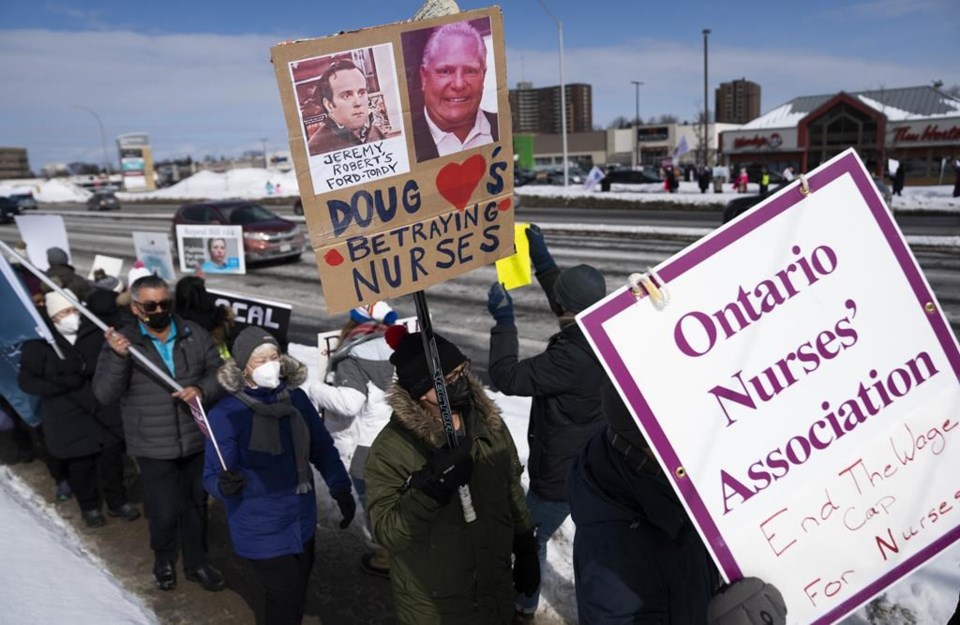Unions representing some 70,000 hospital workers in Ontario renewed their calls Thursday for the province to address staffing shortages contributing to recent emergency room closures, suggesting measures such as raising wages and putting in financial incentives to boost hiring.
The Ontario Council of Hospital Unions and SEIU Healthcare have sent a letter to Premier Doug Ford outlining a number of actions they say the province should take to reduce labour shortages in health care.
Those include repealing Bill 124, provincial legislation introduced in 2019 that limits wage increases in public-sector contracts to one per cent a year.
Those provisions were set to remain in effect for three years, and Ford has recently said he would take inflation into consideration during upcoming contract negotiations with the health-care sector.
The letter also urges the premier to ban the use of nursing agency staff, which it says are paid two to three times more than hospital workers; work with unions to turn part-time or casual positions into full-time ones; and implement an "aggressive plan" to lure thousands of licensed nurses and other health-care staff not currently practising in their field back to the sector.
The unions have also issued an open letter to the Ontario Hospital Association, asking that it take several steps to improve transparency regarding the current crisis, as well as fill vacancies.
Among their requests is the creation of a website that would show in real time the staffing situation at each hospital, with green indicating full staffing levels, yellow a full staff but with no margin for absences, and red for understaffing or compromised care.
"The working environment for health-care workers in hospitals at the moment is terribly, terribly tense," said Michael Hurley, president of OCHU, which is part of the Canadian Union of Public Employees.
"This is an exhausted workforce, this is an anxious workforce. It's ground down by the pandemic, it's ground down by the lack of support it's had, and it needs to be supported now in order for it to come through for the people of Ontario."
A spokesperson for Health Minister Sylvia Jones said efforts to recruit and train health-care workers are already underway, including a payment of up to $5,000 for eligible nurses announced in March to help with retention.
Other measures include tuition reimbursement for nursing graduates who commit to practising in underserved communities, and funding to bring thousands more nurses and personal support workers into the system, Stephen Warner said in an email.
The Ontario Hospital Association said it values the hard work and dedication shown by front-line health-care workers, and is working with the province and Ontario Health to make sure hospitals and other health providers have as much support as possible.
"At this critical time it is essential that everyone stand together and work to have a 'Team Ontario' approach to address the very challenging issues facing the health-care system," Anthony Dale, the association's president and CEO, said in a statement.
"Unfortunately, this commitment to common cause was not demonstrated today by the leaders of SEIU and CUPE/OCHU during their press conference."
The association said it surveyed hospitals on staffing levels this spring, with just over 60 per cent responding. Results showed a total vacancy rate for full- and part-time permanent positions of more than 12 per cent for registered nurses and more than 10 per cent for registered practical nurses, as of March 1.
Some Ontario hospitals warned earlier this month that emergency department closures could be a recurring issue this summer, particularly for those in smaller communities.
Communities such as Perth, Clinton, Listowel and Wingham have recently seen ERs close for hours or even days.
The OHA has previously pointed to staff shortages and capacity issues, saying these are causing backlogs across the hospital system. It said rural and northern Ontario were particularly affected.
Organizations representing doctors and nurses have repeatedly said workers are burned out, with many leaving their jobs as a result.
Those sentiments were echoed by the unions and two nurses in a news conference Thursday.
"We're breaking down, the entire system is breaking down," said Justine Champagne, a front-line nurse at a Toronto-area hospital and member of SEIU Healthcare.
Champagne said nurses typically care for four to five patients at a time, but that number has now risen to as many as seven due to understaffing.
She said it's also "not rare" for nurses to be called back into work as they're heading home from an eight-to-12-hour shift.
Pam Parks, a nurse who works in the emergency room of a Toronto-area hospital and a member of OCHU, said labour shortages have left the province's hospitals "on life-support."
"It's crushing to be working inside a hospital or long-term care home today, knowing that you and your co-workers are beyond burned out and that patients and residents aren't getting seen in a timely way or are not at all," she said.
"This is very disheartening, frustrating, mentally and physically exhausting for us on the frontlines," Parks said in asking the province for support.
This report by The Canadian Press was first published July 21, 2022.
Paola Loriggio, The Canadian Press




